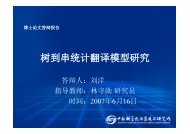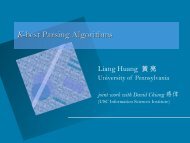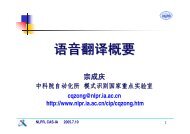Machine Translation with Lattices and Forests
Machine Translation with Lattices and Forests
Machine Translation with Lattices and Forests
You also want an ePaper? Increase the reach of your titles
YUMPU automatically turns print PDFs into web optimized ePapers that Google loves.
tion, given a set of edges L of a lattice for an input<br />
sentence C = c 0 ..c n−1 <strong>and</strong> a PCFG grammar:<br />
a 4-tuple 〈N, Σ, P, S〉, where N is a set of nonterminals,<br />
Σ is a set of terminal symbols, P is a<br />
set of inference rules, each of which is in the form<br />
of X → α : p for X ∈ N, α ∈ (N ∪ Σ) ∗ <strong>and</strong> p is<br />
the probability, <strong>and</strong> S ∈ N is the start symbol. The<br />
deductive proof system (Figure 4) consists of axioms,<br />
goals <strong>and</strong> inference rules. The axioms are<br />
converted by edges in L. Take the (5, 7, NN) associated<br />
<strong>with</strong> a weight p 1 for example, the corresponding<br />
axiom is NN → tǎolùn : p 1 . All axioms<br />
converted from the lattice are shown in Figure 3(b)<br />
exclude the italic non-terminals. Please note that<br />
all the probabilities of the edges L in a lattice are<br />
taken into account in the parsing step. The goals<br />
are the recognition X 0,n ∈ S of the whole sentence.<br />
The inference rules are the deductions in<br />
parsing. Take the deduction (*) for example, it will<br />
prove a new item NP 0,5 (italic NP in Figure 3(b))<br />
<strong>and</strong> generate a new hyper-edge e ∗ (in Figure 5(b)).<br />
So the parsing algorithm starts <strong>with</strong> the axioms,<br />
<strong>and</strong> then applies the inference rules to prove new<br />
items until a goal item is proved. The final whole<br />
forest for the input lattice (Figure 2) is shown in<br />
Figure 5(b). The extra hyper-edges of lattice-forest<br />
are highlighted <strong>with</strong> dashed lines, which can inference<br />
the input sentence correctly. For example:<br />
“yǔ” is tagged into P rather than CC.<br />
3.3 Faster Parsing <strong>with</strong> Most-refined Lattice<br />
However, our statistics show that the average number<br />
of characters n in a sentence is 1.6 times than<br />
the number of words n w in its 1-best segmentation.<br />
As a result, the parsing time over the characters<br />
will grow more than 4 times than parsing over<br />
the 1-best segmentation, since the time complexity<br />
is O(n 3 ). In order to alleviate this problem, we reduce<br />
the parsing time by using most-refined segmentation<br />
for a lattice, whose number of tokens<br />
is n r <strong>and</strong> has the property n w ≤ n r ≤ n.<br />
Given a lattice <strong>with</strong> its edges L over indexes<br />
(0, .., n), a index i is a split point, if <strong>and</strong> only if<br />
there exists some edge (i, j, X) ∈ L or (k, i, X) ∈<br />
L. The most-refined segmentation, or ms for<br />
short, is the segmentation result by using all split<br />
points in a lattice. For example, the corresponding<br />
ms of the example is “Bùshí yǔ Shālóng jǔ xíng<br />
tǎo lùn” since points 1 <strong>and</strong> 4 are not split points.<br />
Item form:<br />
Axioms:<br />
Infer. rules:<br />
X i,j<br />
(i, j, X) ∈ L<br />
X i,j : p(i, j, X)<br />
X i,k : p 1 Y k,j : p 2<br />
Z → XY : p ∈ P<br />
Z i,j : pp 1 p 2<br />
Goals: X 0,n<br />
Figure 4: Lattice parsing as deductive proof system.<br />
The i, j, k are the indexes between characters.<br />
Figure 3(c) shows the CKY parsing cells over<br />
most-refined segmentation, the average number<br />
of tokens n r is reduced by combining columns,<br />
which are shown <strong>with</strong> red dashed boxes. As a result,<br />
the search space is reduced <strong>with</strong>out losing any<br />
derivations. Theoretically, the parsing over fs will<br />
speed up in O((n/n r ) 3 ). And our experiments in<br />
Section 6 show the efficiency of our new approach.<br />
It turns out that the parsing algorithm developed<br />
in lattice-parsing Section 3.2 can be used here<br />
<strong>with</strong>out any change. The non-terminals inducted<br />
are also shown in Figure 3(c) in italic style.<br />
4 Rule Extraction <strong>with</strong> Lattice & Forest<br />
We now explore the extraction algorithm from<br />
aligned source lattice-forest <strong>and</strong> target string 2 ,<br />
which is a tuple 〈F, τ, a〉 in Figure 5(b). Following<br />
Mi <strong>and</strong> Huang (2008), we extract minimal rules<br />
from a lattice-forest also in two steps:<br />
(1) frontier set computation<br />
(2) fragmentation<br />
Following the algorithms developed by Mi <strong>and</strong><br />
Huang (2008) in Algorithm 1, all the nodes in<br />
frontier set (fs) are highlighted <strong>with</strong> gray in Figure<br />
5(b).<br />
Our process of fragmentation (lines 1- 13) is<br />
to visit each frontier node v <strong>and</strong> initial a queue<br />
(open) of growing fragments <strong>with</strong> a pair of empty<br />
fragment <strong>and</strong> node v (line 3). Each fragment is associated<br />
<strong>with</strong> a list of expansion sites (front) being<br />
2 For simplicity <strong>and</strong> consistency, we use character-based<br />
lattice-forest for the running example. The “Bù” <strong>and</strong> “shí”<br />
are aligned to the same word “Bush”. In our experiment,<br />
we use most-refined segmentation to run lattice-parsing <strong>and</strong><br />
word alignment.









